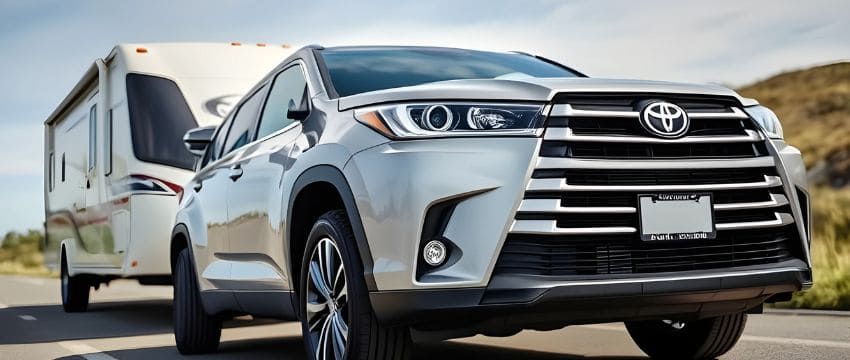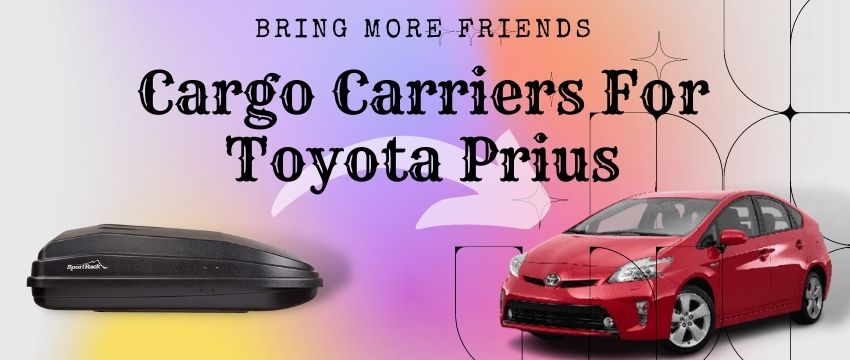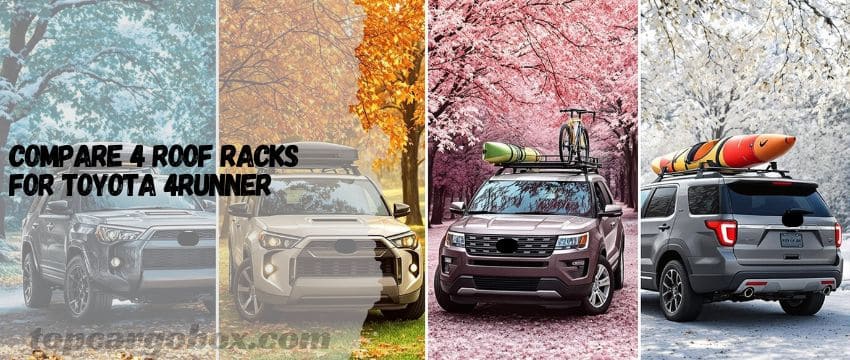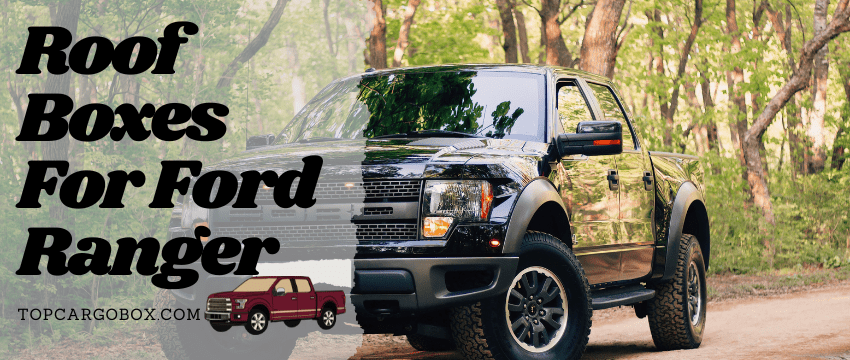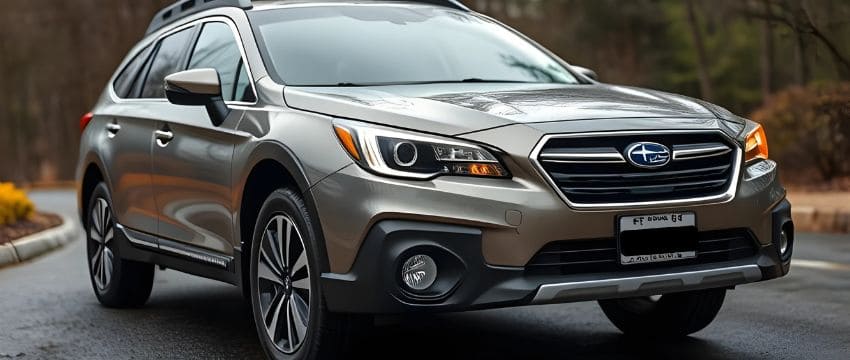Hey there, road tripper! So, you’ve got your sleek Cadillac Lyriq – totally awesome choice, by the way – and you’re eyeing up that roof for some extra cargo space. Maybe it’s for a family ski adventure, a big camping haul, or just freeing up precious cabin room. Smart thinking! But before you start loading that roof box like it’s moving day, you absolutely need to know: How much weight can a Cadillac Lyriq roof cargo box actually handle? Seriously, getting this wrong isn’t just inconvenient; it can be downright dangerous. Let’s break it down so you can pack smart, pack safe, and hit the open road with total confidence. No guesswork, just the facts you need.
Getting to Know Your Lyriq’s Roof: The Foundation Matters
Alright, first things first. You can’t just slap any old box on your Lyriq’s roof and hope for the best. The whole system relies on what’s actually built into your car. Think of it like building a house – you need a solid foundation! Your Lyriq’s roof is designed to handle specific loads, but it needs the right hardware to do it safely.
- Factory-Installed Rails vs. Aftermarket: How’s your Lyriq set up? Did it come from the factory with those sleek, integrated side rails running front to back? That’s the ideal starting point! These rails are actually part of the vehicle’s structure, engineered to handle loads. If your Lyriq doesn’t have these factory rails, don’t panic! You’ll need to install a complete aftermarket roof rack system designed specifically for the Lyriq. This isn’t just about clipping on some cheap crossbars; it needs proper feet that anchor securely to the vehicle’s designated mounting points. Skipping this step is asking for trouble – imagine your precious cargo, or worse, the box itself, flying off on the highway! Not cool. Always, always use equipment rated for your specific vehicle. Generic “one-size-fits-all” racks? Forget it. They’re a recipe for disaster on a modern EV like the Lyriq.
- The Critical Role of Crossbars: Okay, so you have the factory side rails or a proper aftermarket base system. Next up: crossbars. These are the horizontal bars that actually span the width of your roof, and they’re the direct connection point for your cargo box. This is where the first major weight limit comes into play. Cadillac specifies a maximum crossbar load capacity. You must find this number! It’s usually listed in your Lyriq’s owner’s manual (dig that out!) or on the Cadillac website specs for your model year. Don’t just assume it’s the same as your neighbor’s SUV – it absolutely isn’t! This limit is the absolute maximum weight everything on the crossbars can weigh combined – that means the cargo box itself plus everything you put inside it. Exceeding this is risking damage to your roof, the rack system, and compromising handling and safety. No big deal? Actually, it’s a huge deal.
Roof Cargo Box Basics: It’s Not Just About Space!
You’re probably browsing cargo boxes thinking, “Wow, that giant one holds a ton of gear!” And yeah, volume is important. But when it comes to roof loading, weight capacity is king. A massive box that can only hold light pillows isn’t much help for your camping gear, right?

- Box Weight vs. Payload Capacity: Every single roof cargo box has two crucial weight specs you must check:
- Its Own Weight (Tare Weight): How heavy is the empty box itself? This varies a lot – hard-shell boxes are generally heavier but more durable, while soft-shell bags are lighter but offer less protection. You’ll see weights ranging from maybe 25 pounds for a basic bag to 60 pounds or more for a large, rugged hard-shell box.
- Its Maximum Load Capacity (Payload): This is the manufacturer’s stated limit for how much weight you can safely put inside the box. This number is absolutely critical! It’s not a suggestion; it’s an engineering limit based on the box’s materials, design, and how it attaches to the crossbars. You might find boxes with payloads as low as 100 pounds up to maybe 165 pounds for heavy-duty models. This is your hard ceiling for stuff inside the box.
- The Material Matters (A Lot!): What’s the box made of? Fiberglass shells are super tough but heavy. ABS plastic (like high-grade Lego plastic) is lighter and very durable – a popular choice. Polycarbonate is super tough and light but can be pricier. Soft bags are often made of heavy-duty PVC or polyester but rely entirely on the structure of whatever you pack inside. Why does this matter? The material directly impacts both the box’s own weight and its structural integrity under load. A cheaper, flimsy box might buckle or crack if overloaded, even if the weight seems within its stated limit during a gentle test in your driveway. Real-life highway speeds, bumps, and wind forces are a whole different ballgame! You get what you pay for here, for real.
The Golden Number: What’s the Lyriq’s Actual Roof Weight Limit?
Okay, deep breath. This is the info you really came for. Based on Cadillac’s specifications for the Lyriq:
- Cadillac Lyriq Factory Roof Rail Maximum Load Capacity: Cadillac states the maximum weight capacity for items placed on the factory-installed roof rails (meaning the load on the crossbars) is 165 pounds (75 kilograms). This is the absolute maximum total weight your roof system is designed to carry.
- Crossbars are Key: Remember, this 165 lbs limit applies to the combined weight resting on the crossbars. This includes:
- The weight of the cargo box itself (its tare weight).
- PLUS the weight of everything you pack inside it (the payload).
- PLUS the weight of the crossbars themselves (though this is usually minimal, around 10-20 lbs for a pair).
- PLUS anything else strapped directly to the crossbars (like bikes or kayaks, if not using a box).
Breaking Down the Math: The Reality Check
Let’s make this crystal clear with some real math, because numbers don’t lie! Imagine you find an awesome cargo box:
- Box Weight (Tare): 40 lbs
- Box Payload Capacity (Max Load Inside): 150 lbs (Sounds great, right?)
Can you actually use all 150 lbs inside that box on your Lyriq? Let’s see:
- Box Weight: 40 lbs
- Stuff Inside: 150 lbs
- Total Load on Crossbars: 40 lbs + 150 lbs = 190 lbs
Uh oh. Your Lyriq’s roof limit is 165 lbs. 190 lbs is way over! Even without considering the small weight of the crossbars themselves, you’re already 25 lbs over the vehicle’s maximum capacity. That’s like throwing an extra medium-sized dog up there! Not safe.
So, what can you realistically carry?
- Box Weight: Let’s choose a lighter, efficient box – say 35 lbs.
- Lyriq Roof Limit: 165 lbs
- Minus Box Weight: 165 lbs – 35 lbs = 130 lbs
This means your actual maximum cargo weight inside the box, in this scenario, is only 130 lbs. And that’s before you account for the crossbar weight! You need to leave a little buffer. Aim for no more than 120-125 lbs inside that box to stay safely under the 165 lbs total limit. See how the box’s own weight eats significantly into your usable capacity? That’s why choosing a lighter box is often smarter for EVs like the Lyriq, where every pound impacts range slightly. Who knew packing could involve so much math? But trust me, it’s worth getting right.
Real-Life Examples: What Does 120-130 lbs Actually Look Like?
Okay, 120 lbs sounds like a lot… until you start packing. Let’s make this tangible with some everyday scenarios. What can you actually fit while staying safe?
- The Family Ski/Snowboard Trip:
- 4 Pairs of Adult Skis/Snowboards + Boots: Easily 60-80 lbs
- Ski Jackets/Pants (4 sets): 20-30 lbs
- Helmets/Goggles: 5-10 lbs
- Total: ~85-120 lbs (This is pushing the upper limit! Pack carefully and weigh your gear bag before loading. Maybe put the bulkiest but lightest items like jackets in the roof box, and heavier boots inside the cabin if possible).
- Weekend Camping for Four:
- 4 Sleeping Bags + 4 Sleeping Pads: 25-40 lbs
- Large Tent: 10-20 lbs (depends heavily on the tent)
- Camp Chairs (4 compact ones): 15-25 lbs
- Camp Kitchen (Pots, stove, fuel if allowed – check box rules!): 15-25 lbs
- Total: ~65-110 lbs (More manageable, but still requires conscious packing. Heavy items like cast iron or full water jugs? Those belong inside the vehicle, low down).
- College Move (Essential Soft Goods):
- Bedding (Comforters, pillows): 20-30 lbs
- Clothing (in duffels, not suitcases!): 40-60 lbs
- Towels, curtains, lightweight decor: 10-20 lbs
- Total: ~70-110 lbs (Books, electronics, mini-fridge? Absolutely not for the roof box! Keep those heavy, dense items inside the car).
See how quickly soft, bulky items add up? That big, light duffel bag of clothes might look manageable, but throw a few of them in, and you’ll hit the limit faster than you think. Always, always weigh your packed box before hitting the road. A simple bathroom scale works! Guessing sucks, and being wrong has consequences. Feeling overwhelmed? Check out our guide on understanding how much weight your car roof can hold for more general principles that apply here too.
Why Overloading is a Seriously Bad Idea (Beyond the Obvious)
Come on, we’ve all been tempted to squeeze in just one more thing. But overloading your Lyriq’s roof isn’t just about maybe breaking the box or rack. The risks are real and impact your whole drive:
- Handling Gets Scary: Adding significant weight up high drastically changes your Lyriq’s center of gravity. Think about it – that weight is perched way above the axles. This makes the vehicle feel tippier, especially during cornering, lane changes, or avoiding sudden obstacles. It increases body roll significantly. Emergency maneuvers become much harder and more dangerous. Suddenly, that winding mountain road feels way more intense. Not exactly relaxing.
- Stopping Power Takes a Hit: More mass = more kinetic energy. Your Lyriq’s excellent brakes now have to work significantly harder to stop all that extra weight riding high. Your stopping distances will increase, sometimes dramatically, especially at higher speeds or on downhill grades. That extra split-second could mean the difference between a scare and an accident. Totally not worth the risk.
- Range Anxiety Gets Worse: While the Lyriq has impressive range, physics is physics. Extra weight, especially high up creating aerodynamic drag, means the motors have to work harder. You will see a noticeable reduction in your driving range per charge. How much? It depends on speed, the box’s aerodynamics, and the weight, but expect 10-25% less range or potentially more. Plan your charging stops accordingly! That extra weight means more grunt from the motors.
- Damage is Expensive: Exceeding weight limits stresses everything:
- The Box: Can crack, deform, or have its mounting mechanisms fail.
- The Crossbars: Can bend, crack, or loosen from their mounts.
- The Roof Rails/Mounting Points: The most serious! Can deform the roof panel itself, damage the structural mounting points, or cause leaks. Repairing this is incredibly expensive. We’re talking body shop level, potentially thousands of dollars. Is that sleeping bag worth it? No way!
- Potential for Catastrophe: In the worst case, an overloaded or poorly secured box can detach completely. Imagine that happening at 70 mph on the freeway. It’s terrifying and could cause a major accident for you and others. Absolutely not acceptable. Learn more about the dangers of putting too much weight on your roof rack.
Mastering Weight Distribution: It’s Not Just the Total, It’s How You Pack
Alright, so you’ve nailed the total weight limit. Awesome! But hold up – how you pack that box matters just as much. Even if you’re under the max, poor distribution can cause problems. Think of it like balancing a tray of drinks; you want it centered and stable.
- Front-to-Back: Center it Over the Bars! Your crossbars are the strong points. The heaviest items should be placed directly above, or slightly behind, the front crossbar, and then weight should taper towards the rear. Avoid:
- Loading all the heavy stuff way at the back of the box. This creates a lever arm, putting excessive downward force on the rear bar and potentially lifting force on the front bar, stressing the mounts. It can also make the rear of your car sag and affect headlight aim.
- Piling everything right at the very front. Similar lever effect, stressing the front mounts and potentially making steering feel heavy or vague.
- Side-to-Side: Keep it Balanced! Distribute weight evenly between the driver and passenger sides. A lopsided load makes the car pull slightly to one side, increases stress on one crossbar and its mounts, and feels unstable in crosswinds. Pack like you’re balancing scales.
- Securing the Load Inside the Box: Don’t just throw stuff in! Use packing cubes, straps, or even towels to tightly pack and secure items within the box. Why? Because loose items shifting around during driving create dynamic loads – meaning the forces acting on the box and rack are much higher than just the static weight. A 20 lb bag sliding and slamming into the end of the box during braking can generate forces equivalent to 50 lbs or more! That dynamic shock is brutal on equipment. Pack tight, pack secure. This is crucial for proper roof cargo box weight distribution.
- Low and Centered Wins: Whenever possible, pack heavier, denser items lower in the box, closer to the roof. This helps keep the overall center of gravity as low as possible, improving stability. Save the lighter, bulkier items (like sleeping bags) for the top.
Choosing the BEST Cargo Box for Your Lyriq: Features Beyond Size
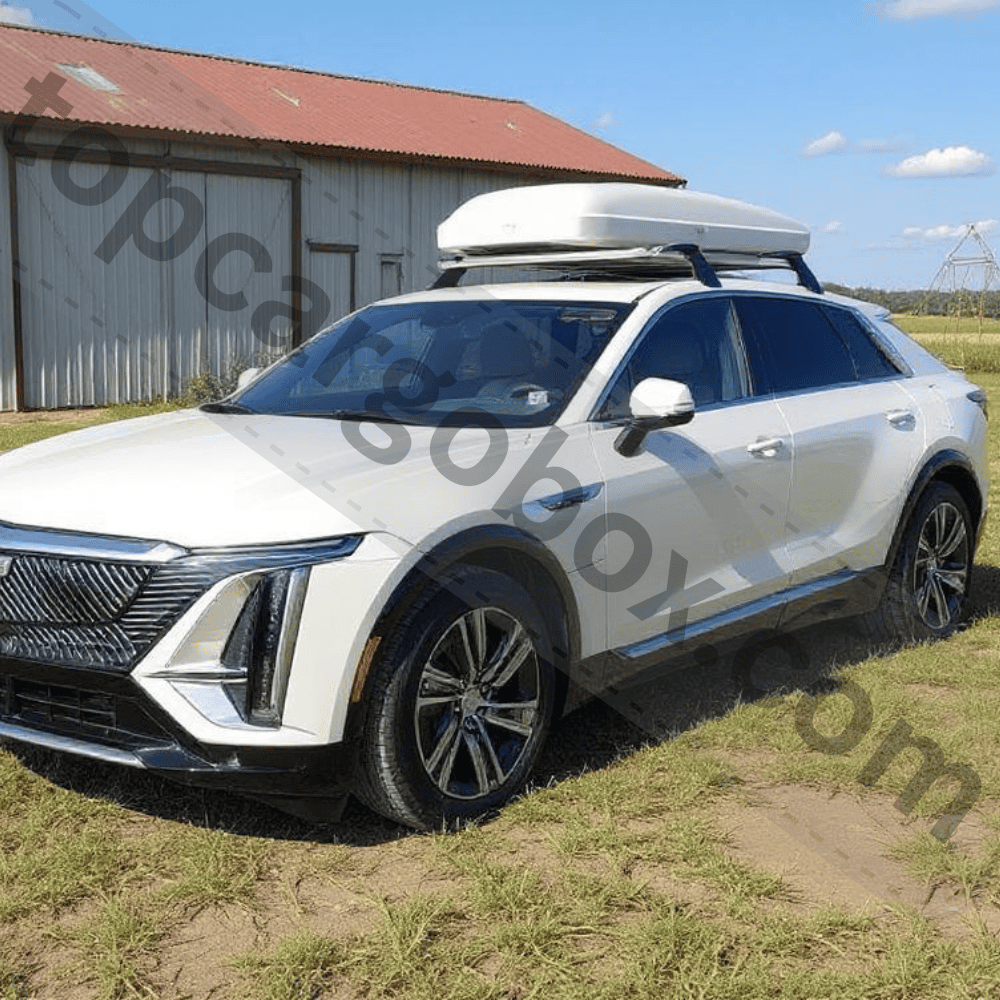
With that 165 lbs total limit in mind, choosing the right box becomes a strategic game. It’s not just about cubic feet! Here’s what to prioritize:
- Weight is King (Seriously!): Look for boxes known for being lightweight relative to their size and durability. Every pound saved on the box itself is a pound you can use for your gear! ABS plastic often hits a good sweet spot. Check manufacturer specs carefully – tare weight matters big time here.
- Aerodynamics Matter for Range: The Lyriq is a slippery EV. A giant, brick-shaped roof box will create significant drag, hurting your range more than a sleek, low-profile design. Look for teardrop shapes or boxes specifically marketed as aerodynamic. Your battery will thank you!
- Ease of Loading: How tall is your Lyriq? Some roof boxes open from both sides, which is super convenient. Others might have a lower opening height or built-in steps. Consider how easily you (and maybe other family members) can actually reach and load the thing. Straining your back trying to heave a heavy bag up there? That sucks.
- Security & Weather Protection: Hard-shell boxes generally offer better security against theft (though determined thieves can get into anything) and superior protection from rain, snow, dust, and highway debris compared to soft bags. If you’re carrying valuable gear or need absolute weatherproofing, hard-shell is usually the way to go.
- Mounting System Compatibility: Double-check that the box you choose is compatible with the specific crossbars you have (or plan to get) for your Lyriq. Most use standard T-track or similar, but it’s always wise to verify. Nothing worse than getting the box home and realizing it doesn’t clip onto your bars!
Cadillac Lyriq Roof Cargo Box Key Specs Summary Table
Feature | Specification/Consideration | Why It Matters |
|---|---|---|
Vehicle Roof Limit | 165 lbs (75 kg) Maximum Load on Crossbars | The ABSOLUTE ceiling for combined weight (box + contents + crossbars). Exceeding risks damage and unsafe handling. |
Crucial Weight Math | Box Weight + Gear Weight ≤ 165 lbs (Include crossbar weight!) | Your usable gear capacity is 165 lbs MINUS the box weight & crossbar weight. A lighter box = more usable capacity. |
Target Gear Weight | Aim for ≤ 120-130 lbs inside the box to safely stay under 165 lbs total | Provides a necessary safety buffer. Realistically, this is your practical max for belongings inside the cargo container. |
Crossbar Requirement | MUST use crossbars rated for Lyriq & compatible with box. Factory rails or proper aftermarket system required. | Provides the secure mounting foundation. Never attach a box directly to factory side rails without crossbars. |
Optimal Box Features | Lightweight construction, Aerodynamic shape, Secure mounting compatibility, Good internal securing points, Easy loading access. | Maximizes usable payload, minimizes range impact, ensures safety, makes packing easier, protects gear. |
Critical Packing Rules | Heaviest items centered over front crossbar & low in box. Distribute weight evenly side-to-side. SECURE all items inside to prevent shifting. | Prevents damaging leverage effects, maintains vehicle stability, avoids dangerous dynamic loads from shifting gear. |
Major Overloading Risks | Dangerous handling (tippiness), Longer stopping distances, Reduced driving range, Damage to box/crossbars/roof, Potential for detachment causing accident. | Highlights why sticking to the limit is essential for safety, vehicle integrity, and efficiency. |
Installation and Loading: Getting it Right on the Driveway
Alright, you’ve got the perfect box, you know the weight limits, and you’ve packed smartly. Now, let’s get it on the car safely! Doing this right in your driveway saves headaches (or worse) down the road.
- Follow the Instructions (Seriously!): I know, reading manuals isn’t fun. But both your roof rack/crossbar system and your cargo box came with specific installation guides. Read them thoroughly. Each system has nuances. Getting the mounting clamps or bolts torqued correctly is vital for security. Skipping steps or winging it is a gamble you don’t want to take. Set aside the time and do it right.
- Two-Person Job Recommended: Lifting even a lightweight empty box onto the roof of a Lyriq is awkward. Having a buddy helps immensely – one to guide and position, the other to lift. Much safer for your back and your car’s paint! Trying to muscle it up solo often leads to scratches or dents. Not awesome.
- Positioning is Key: Place the box so that the front clamp system is positioned just behind the front crossbar. This ensures the box is securely anchored to the strongest point. Most boxes have markings or instructions showing optimal placement relative to the bars. Don’t just center it visually; follow the guide.
- Torque Matters: If your box uses bolts or specific clamps that require tightening to a torque setting (often measured in Newton-meters or Nm), use a torque wrench. Overtightening can crack plastic components or damage the crossbars. Under-tightening risks the box loosening. A torque wrench takes the guesswork out. It’s worth the investment or borrow one!
- The Final Tug Test: Once everything is mounted and loaded (but before you drive off!), give the box a firm, multi-directional tug. Try to move it forward, backward, side-to-side, and lift slightly. It should feel rock solid with absolutely no movement on the crossbars. Any shifting or play means something isn’t tight enough – recheck all mounting points immediately. Do this test again after your first 25-50 miles of driving and periodically during long trips. Things can settle or vibrate loose.
Safety First, Adventure Second: Your Pre-Drive Checklist
You’re almost ready to roll! Let’s run through a quick safety checklist before you hit the ignition:
- Weight Verified? Did you physically weigh the loaded box on a scale? No estimating!
- Total Under 165 lbs? Confirm box weight + gear weight (+ crossbar weight) ≤ 165 lbs.
- Gear Secured Inside? Is everything inside the box packed tightly and strapped down? No loose items shifting?
- Box Mounting Secure? Passed the multi-directional tug test? All clamps/bolts tight? Torqued correctly if applicable?
- Doors Latched? Are both the main lid and any side access doors on the box fully and securely latched? Give them a firm check.
- Clearance Checked? Remember the box is up there! Be extra cautious driving into garages, under low branches, or through drive-thrus. Know your new total height.
- Driving Mode Adjusted? Be prepared for different handling. Start cautiously. Allow more space for braking. Reduce speed, especially on curves, in crosswinds, or on bumpy roads. Your Lyriq is taller and heavier up top now. Take it easy, especially at first.
- Range Expectations Managed? Reset your trip meter and monitor range consumption closely, especially early in the trip. Plan charging stops more conservatively than usual. That aerodynamic drag and extra weight grunt down efficiency.
Beyond the Box: What About Other Roof Rack Gear?
Maybe you’re thinking, “What if I just want to strap some bikes or a kayak up there instead of using a box?” Totally valid! The same core principle applies: the 165 lbs total crossbar load limit is the law for your Lyriq’s roof.
- Bike Racks: Bike racks themselves have weight (10-25 lbs typically), and your bikes add more. A heavy e-bike can easily weigh 50-70 lbs. Two e-bikes plus a rack could quickly approach or exceed the 165 lbs limit! Always check the rack’s own weight and its load capacity, and then ensure the total (rack + bikes) stays under 165 lbs. Don’t forget the weight of the crossbars themselves. It adds up fast! Get the lowdown on bike rack weight limits and considerations.
- Kayaks, Canoes, SUP Boards: These are often long and catch wind. While a single kayak might weigh 45-70 lbs, the rack system (often specialized carriers or J-cradles) adds significant weight. Two kayaks plus carriers can easily push past the limit. Wind loading (the force from wind hitting the object) is also a major factor with these large, non-aero items, adding stress beyond just the static weight. Secure them extremely well and drive cautiously.
Wrapping It Up: Pack Smart, Drive Safe, Enjoy the Ride!
Phew! That was a lot, but hey, knowing this stuff means you can adventure further and safer with your awesome Cadillac Lyriq. Let’s recap the golden rules:
- Your Lyriq’s roof limit is 165 lbs TOTAL on the crossbars. This is non-negotiable.
- Your usable cargo weight is 165 lbs MINUS the weight of the cargo box itself and the crossbars. Choose a light box to maximize what you can carry!
- Weigh everything. Don’t guess. Your bathroom scale is your new best friend for packing.
- Pack smart: Center weight over the front bar, keep it balanced side-to-side, and SECURE everything inside the box.
- Install meticulously: Follow instructions, torque properly, do the tug test!
- Drive differently: Allow more stopping distance, slow down for curves and wind, and watch your range.
Respecting these limits isn’t about being a buzzkill; it’s about protecting your investment (your car!), your precious cargo, and most importantly, everyone on the road. Knowing you’ve packed safely lets you truly relax and enjoy the journey. So, grab that (appropriately sized and weighted!) gear, load up smart, and hit the road in your Cadillac Lyriq with total peace of mind. Where will your next adventure take you? Happy and safe travels! Catch you later!
Our team is creating outdoor-gear relevant articles with passion. If our articles can help you to find the correct solutions for your questions, we will be happy about that. In the content creation process, we usually collect accurate and useful information online or offline to compile our content in an organized way. Consequently, we can guarantee that you can discover some expected answers to your questions. We appreciate your time on our site.





